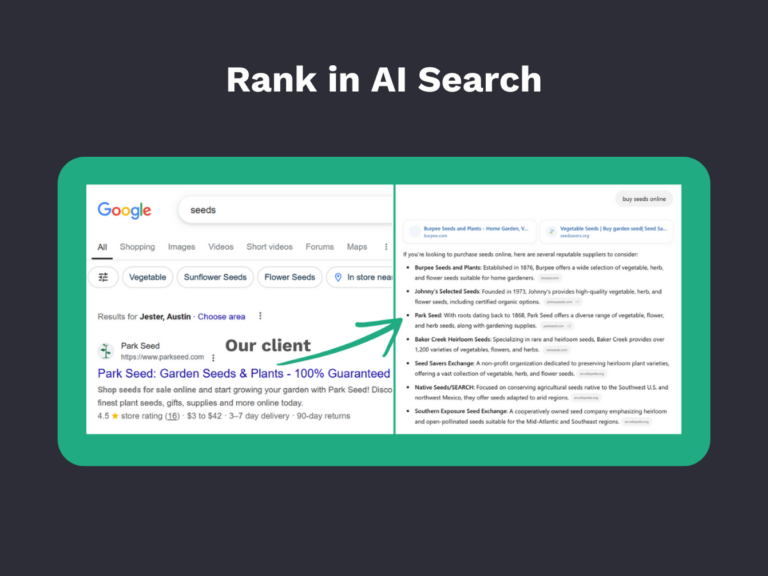Nassim Taleb’s “Black Swan” framework explains how individual events can have massive impacts. One could argue that we’re witnessing a Black Swan event in marketing, with Google’s recent Helpful Content Update and the rise of AI Overviews (AIOs).
Our study of 400 popular financial search queries across 1025 websites in the financial services niche, shows that AIOs are diverting significant traffic from these websites. That’s potentially millions of lost opportunities.
But here’s what Taleb would tell you: Black Swans create opportunities for those who know how to spot them.
In this article, we’ll show you how to:
- Identify the hidden signals in AIOs that predict SEO shifts
- Apply “Antifragile SEO”: Turn AIOs into your competitive advantage
Whether you’re an RIA or a retirement planner, understanding these trends isn’t just about your SEO strategy — it’s about future-proofing your entire financial services business.
Methodology: how we measured the impact of AI Overviews in finance
We conducted our study using data collected in the first week of June. Given the rapidly evolving nature of search engine algorithms and the implementation of AI-driven features, we’ll keep an eye on how this changes over the coming weeks and months.
Our data collection and analysis process relied on a combination of commercial and proprietary tools, like Semrush for gathering keyword data and SERP features, and in-house tools to dive deeper into specific aspects of AIOs and their relationship with other search metrics.
Key metrics analyzed in our study included:
- Presence of AIOs in search results
- Query characteristics (length, word count, presence of question words)
- Relationship between AIOs and other SERP features
- Citation patterns within AIOs
- Correlation between organic search performance and AIO citations
- Impact on click-through rates (CTR) for organic results
By focusing on these metrics, we aimed to provide a holistic view of how AIOs are functioning within the financial services niche and what factors might influence their appearance and impact.
Prevalence of AIOs in Financial Services Queries
Our analysis of 400 financial services keywords revealed that AI Overviews (AIOs) are present, but not yet dominant, in this sector’s search landscape. Specifically:
9.75% of the analyzed queries triggered AIOs in the search results
This relatively low percentage suggests that while AIOs are being implemented in financial services searches, their integration is still in its early stages.
Here’s what this means:
- Opportunity for organic results: There is still ample opportunity for organic results to capture user attention in the majority of financial services searches.
- Need for ongoing monitoring: This percentage is certain to evolve over time. Continuous monitoring of AIO prevalence will be crucial for meaningful strategy choices for your SEO and marketing as a whole.
In the following sections, we’ll delve deeper into the characteristics of queries that trigger AIOs and the potential impact on organic traffic, providing actionable insights for SEO professionals in the financial services sector.
What types of queries are triggering AI Overviews?
We found some interesting patterns in the types of queries that tend to trigger AIOs. These insights can help you tailor your strategies to target (or avoid, if you so choose) AIO-rich search results.
A. Query Length Analysis
We observed a notable difference in the length of queries that triggered AIOs compared to those that did not:
- Average character length of queries that triggered AIOs: 28.7 characters
- Average character length of queries that did not trigger AIOs: 24.9 characters
- Average word count of queries that triggered AIOs: 5.0 words
- Average word count of queries that did not trigger AIOs: 4.3 words
In other words, queries that triggered AI Overviews had 15.26% higher character counts and 16.27% higher word counts, on average.
Longer, more specific queries are more likely to trigger AIOs.
B. Presence of “Question Words”
Interestingly, the presence of “question words” such as ‘what’, ‘why’, ‘how’, etc, in queries, seemed to correlate especially strongly with AIOs.
Of the queries that triggered AIOs, 51.6% contained question words, which may not seem that high. But consider the fact that 27.6% of queries that contained question words triggered AIOs, as opposed to just 9.75% of total queries.
In other words, queries that contain question words are 2.8 times more likely to trigger AIOs.
This suggests that targeting specific, long-tail queries in your content could increase the likelihood of appearing in or being cited by AIOs — something to keep in mind when shaping your content strategy.
How are AI Overviews structured?
On average, we found 2.1 sources or pages cited in each AIO. This relatively low number of citations suggests that Google’s AI is synthesizing information from a limited number of sources for each overview.
We identified the top 15 domains cited in AIOs for financial services queries. These were:
- forbes.com
- profitwiseaccounting.com
- investopedia.com
- usatoday.com
- ycharts.com
- incorporate.com
- shoeboxed.com
- treasurydirect.gov
- linkedin.com
- incharge.org
- nerdwallet.com
- schwab.com
- legalzoom.com
- wiegandfinancial.com
- tomcopelandblog.com
The list includes a mix of well-known financial publications, government sites, financial services providers, and niche blogs.
How organic search performance affects AIO citations
We found a very weak relationship between a site’s appearances in organic search results and its rate of citations in AIOs. The analysis yielded an R-squared value of 0.029, or 2.9%, indicating that only a tiny fraction of the variability in AIO citations can be explained by organic search performance.
That said, we believe the relationship between AI overviews and presence in organic search results may be distorted by the presence of outliers. Specifically, directories, forums, marketplaces, and e-commerce sites may be skewing the results, because they were highly prevalent in organic results, but never cited in AIOs.
If these types of sites are excluded from the analysis, the relationship between organic search performance and AIO citations will be much stronger.
When examining the relationship between a site’s domain authority and its likelihood of being cited in AIOs, we found a somewhat stronger correlation. The analysis resulted in an R-squared value of 0.125, or 12.5%, indicating a weak to moderate relationship.
In our earlier study, we already found that other factors, such as content quality, and helpfulness, are playing a larger role in determining rankings, post-HCU.
How AIOs affect organic traffic
We come to the big question you’re asking: all this is great, but how does it affect my traffic from organic search?
An accurate impact on traffic is difficult to determine, since we’d have to compare before-and-after click figures for sites that were earlier ranking #1 for a given set of queries, and that have now not just been replaced by AIOs, but AIOs that continue to cite those same sites.
We’d also need to be confident that the queries consistently produce AIOs, and that they consistently cite or link to the same pages.
That’s are a lot of variables.
Based on our limited sample size, we observed that for one of our client sites, the presence of an AIO seemed to reduce the click-through rate (CTR) to the cited page by approximately 11%, compared to the same query prior to the incidence of AIOs.
So, to nobody’s surprise, AIOs are increasing the trend of zero-click searches.
Implications for financial service business SEO strategies
1. Content quality over quantity: The weak correlation between organic search appearances and AIO citations suggests that simply ranking well for many keywords may not be enough to secure AIO citations.
2. Building Site Authority: Continues to be important not just for traditional SEO, but also for potential inclusion in AIOs.
3. Balancing Act: High domain authority alone isn’t sufficient; content relevance and quality likely play a significant role.
4. Adapting to Zero-Click Searches: As AIOs may satisfy some user queries directly in SERPs, strategies to capture user attention and encourage click-throughs become crucial.
5. Value of AIO Citations: While AIOs might reduce direct clicks, being cited could still provide brand exposure and credibility benefits.
6. Content Depth: Creating content that goes beyond what can be summarized in an AIO may encourage users to seek more detailed information on your site.
How to change your financial services SEO strategy for growth
Based on our findings, we recommend the following strategies for SEO in the financial services sector:
1. Focus on long-form, in-depth content: Create comprehensive content that goes beyond basic answers to encourage click-throughs.
2. Enhance domain authority: Continue building overall site authority through digital PR and authoritative content.
3. Diversify content formats: Explore other content formats (e.g., videos, infographics) that might attract clicks even when an AIO is present.
4. Implement structured data: Help search engines better understand and potentially cite your content in AIOs.
5. Monitor and adapt to AIO presence: Regularly track which queries trigger AIOs in your niche and adjust your content strategy accordingly.
6. Balance traditional SEO with AIO optimization: While optimizing for AIOs is important, don’t neglect traditional SEO practices that still influence overall search visibility.
7. Leverage niche expertise: Demonstrate and highlight unique, in-depth knowledge in specific financial topics to increase chances of AIO citations.
8. Diversify your digital touchpoints: With potential reductions in click-through rates due to AIOs, it’s crucial to engage potential clients across multiple channels. Consider starting a podcast, hosting webinars, or increasing your presence on professional social media platforms to complement your written content.
9. Monitor and adapt: Set up a system to regularly track which of your target keywords are triggering AIOs. Use this information to guide your content creation efforts and to identify new opportunities for reaching potential clients.
Your next step? Choose one of these strategies and implement it this week. Whether it’s outlining a series of question-focused articles or setting up an AIO monitoring system, taking action now will put you ahead of the curve in this evolving digital environment.
If you need help — get in touch, we’re always happy to chat.





no replies